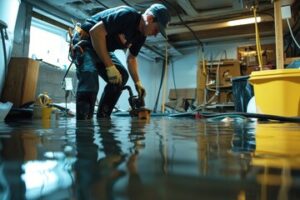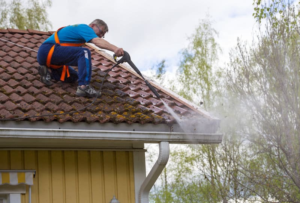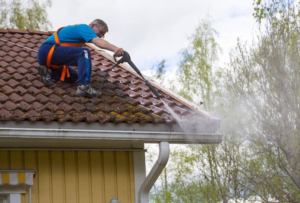The first step in Water Damage Restoration Salt Lake City is removing any standing water. This usually involves using pumps and wet/dry shop vacs.
Professionals also use moisture meters and thermal imaging cameras to check for hidden issues behind walls, under floors, and in ceilings. Hidden moisture can lead to mold growth, which in turn causes additional costs.
Damage Assessment

When water damage happens, it is important to take immediate action to avoid more damage and to prevent health hazards. Water restoration is a multi-step process that requires careful attention to detail to restore the property to its pre-water damage condition. Understanding the steps involved will help property owners better prepare for restoration and understand what to expect.
The first step in the water restoration process is an inspection and assessment of the damage. Professionals will examine the structure of the property and determine how much moisture is present in the affected areas. This information will be used to create a tailored water damage restoration plan for the property. It will also allow technicians to identify what materials may need to be removed or replaced, including drywall and flooring.
During this assessment, professionals will also look for any visible signs of mold growth and deterioration. They will also inspect the structural integrity of the building by checking for sagging ceilings, cracked walls, and weakened supports. They will also use tools like moisture meters to check for the presence of moisture behind walls and in ceiling cavities.
Once the extent of the damage is determined, professionals will create a water restoration plan and determine what items can be saved and which need to be replaced. They will also use this information to develop an estimate for the cost of the restoration work.
One of the most critical aspects of the water damage restoration process is removing standing water. Standing water can cause rapid deterioration of materials and increase the risk of dangerous mold and mildew. Professionals will use industrial-grade pumps and vacuums to remove the water from the affected area.
In some cases, it may be necessary to perform a pack-out, which is the removal of personal belongings from the damaged area. These items will be stored off-site until the restoration is complete.
Once the restoration is complete, property owners will be able to return to their home or business with peace of mind. By implementing regular maintenance and routine inspections of plumbing systems, property owners can significantly reduce their risk of water damage.
Extraction
Water damage can be a nightmare scenario for homeowners and business owners. Not only does it damage furniture, carpeting, and personal belongings, but it also poses a threat to the structure of the property and encourages the growth of mold. This is why prompt and thorough water damage restoration is crucial. In the process, professional restoration experts perform several vital steps including water extraction.
Water extraction involves the immediate removal of excess water in order to mitigate damages and minimize secondary damage. Professionals use specialized equipment including pumps, extractors, and dehumidifiers to remove the water and prepare the area for drying and restoration.
The more time water stays in your home, the worse the damage becomes. Moisture seeps into walls, floors, and furniture, warping them and soaking them beyond repair. This is why rapid and efficient water extraction is critical for preserving your property and possessions.
Once the water is removed, the focus shifts to drying out the affected areas and restoring them to their pre-flood condition. During this step, technicians use high-powered fans and dehumidifiers to draw out the remaining moisture in the air and materials. They also monitor the moisture levels of drywall, wood, and other structural materials until they reach optimal dryness.
Besides being costly, long-term exposure to standing water can pose a health risk for people and pets. It becomes a breeding ground for bacteria and mold, causing health issues like infections, respiratory problems, and allergies. This is why it’s important to take prompt action and hire a water damage restoration company for water extraction services.
A qualified restoration expert has the necessary tools and expertise to handle any situation with ease. They’ll stop the source of water, assess the extent of the damage, and formulate a thorough restoration plan. In addition, they’ll use advanced water extraction and drying techniques to prevent further damage to your property. This includes removing contaminated water and sanitizing the affected area, leaving it healthy and safe for everyone to live in again.
Drying
Getting the area dry as quickly as possible is essential for protecting surfaces, stopping further damage, and preventing mold and mildew. This involves controlling humidity, circulating warm air, and deploying dehumidification equipment to speed up drying times. The longer the area remains saturated, the more extensive and costly the repairs will be. In some cases, it may be necessary to remove and replace drywall and flooring.
Professionals begin by assessing the severity of water damage to determine the best restoration approach. They use moisture detectors and infrared imaging to identify affected areas and the contamination level. Moisture meters are also used to identify hidden moisture pockets in walls and other surfaces. Once the assessment is complete, powerful water mitigation pumps and vacuums are deployed to extract any standing water.
When the contaminated water is removed, the drying process can begin. Affected walls and other surfaces are scrubbed down to remove any debris. Then, specialized drying mats and industrial-grade dehumidifiers are applied to reduce drying time. Industrial air movers are also employed to circulate warm, dry air and control humidity, further reducing drying times and the potential for future problems.
The length of the drying process will depend on the size of the affected area and the layout of the structure. Larger spaces require more energy to heat and circulate air, so they will take longer to dry than smaller rooms. The type of materials affected will also play a role, as porous materials like wood and drywall absorb more moisture than non-porous materials like plastic and fiberglass.
It is important to note that the water damage restoration process begins with ensuring the safety of all family members and pets. It is also important to shut off electricity and gas connections as soon as possible to prevent further damage and safety hazards.
It is also a good idea to move any belongings that can be saved out of the affected area as soon as possible, so they have a better chance of being restored. This is especially true for items that hold sentimental or financial value.
Documentation
Using a water damage restoration checklist can help homeowners, business owners, and facility managers address the problem immediately to minimize damage, save valuable items, and prevent long-term issues. These steps can include identifying the source of the water and its type, performing a thorough inspection, removing standing water, drying affected areas, cleaning and disinfecting affected materials, and repairing or replacing damaged items.
Taking clear photos and videos of the affected area helps to document the extent of the damage. This can also be helpful for insurance claims and for professional restoration planning. Documenting damaged items can also help identify reimbursable expenses for emergency repairs or temporary accommodations. Keeping receipts is important for the claim process.
The first step in addressing water damage is to determine the source of the water and its type. This can be done through visual examination and by locating discoloration on walls or ceilings. It is also important to check for signs of structural problems and mold growth. In addition, the use of moisture meters can detect hidden pockets of water within drywall or under flooring. These areas are often overlooked during initial cleanup and could lead to additional damage or even structural failure later on.
It is important to remove the water as soon as possible to prevent further damage, reduce mold growth, and avoid costly repairs. In small-scale flooding situations, this can be done by mopping and using wet/dry vacuums. In large-scale flood scenarios, professionals will use industrial-grade pumps and vacuums to efficiently remove the water.
Once the water is removed, it’s crucial to dry the affected areas as quickly as possible to avoid long-term damage and health issues. Professionals can use dehumidifiers and fans to help speed up the drying process. Additionally, they can place insulated barriers to prevent further water intrusion and odors.








